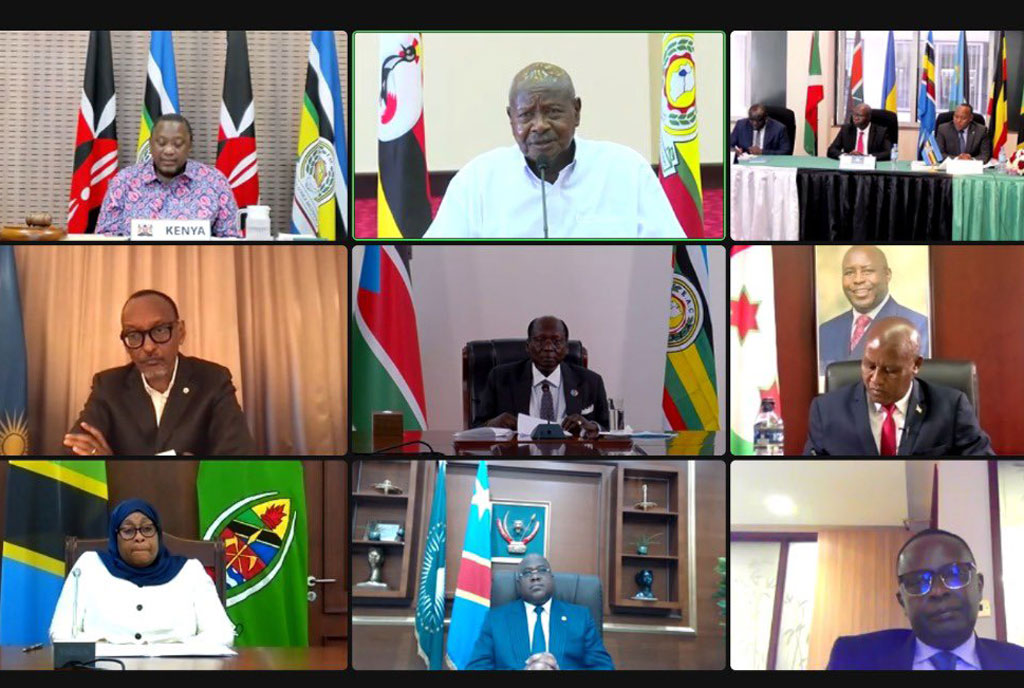
Above: A video grab of East African heads of state attending the virtual summit this week.
People & Power
Prime
East African Community and Congo: Illusion of larger markets
What you need to know:
- Once again, it was at a summit and once again the reasons given were the vague references to closer African unity and the theoretical argument that a closer union meant larger and, therefore, more lucrative markets for all members.
This week, March 28, the Democratic Republic of Congo (DR Congo) was welcomed to the East African Community (EAC).
The original EAC was launched in the 1940s as the East African Common Services Organisation. Its members were Kenya, Tanganyika, and Uganda, at the time still British colonies.
The East African Community proper, launched in 1967 and now simply called the East African Community, had an airline, posts and telecommunications corporation, school of librarianship based at Makerere University, a ports and harbours authority, an East African Development Bank, and several more multinational state-owned corporations.
ALSO READ: Indeed dear EAC, you are welcome to DR Congo
That 1960s East African Community collapsed in July 1977, mostly because of a dispute between Kenya and Tanzania over Kenya’s domination of the EAC to the detriment of the Tanzanian economy (and not because of the presence of the Uganda head of state Idi Amin, as is commonly assumed.)
The EAC consisting of these three original members was revived in November 1999 at a summit in Arusha, Tanzania, attended by presidents Daniel arap Moi of Kenya, Benjamin Mkapa of Tanzania and Yoweri Museveni of Uganda.
As is typical of most governmental and intergovernmental undertakings in Africa, no real thought was given to this 1999 revival.
There was no report into why, in the first place, the EAC had collapsed 22 years earlier and what lessons had been learnt from that.
There was no explanation of how the new chapter of the EAC would be better managed than the 1967-1977 phase.
Later in July 2007, Rwanda and Burundi were admitted to the EAC. DR Congo is the latest entrant into the community.
Once again, it was at a summit and once again the reasons given were the vague references to closer African unity and the theoretical argument that a closer union meant larger and, therefore, more lucrative markets for all members.
Once again, there was no intellectual and analytical homework done prior to Congo’s joining the group.
There was no mention of the recent tiff between Kenya and Uganda, in which Kenya banned Ugandan maize, milk and other products from its markets.
And, of course, there was no mention of the three-year, 2019-2022, closure of its border with Uganda by Rwanda.
Somewhat suspiciously, on March 27, the day before DR Congo was scheduled to be admitted to the EAC, the Tutsi-led Congolese militia, M23, decided to launch an attack in Congo’s eastern region of North Kivu.
The consequences of that M23 attack almost certainly will be the subject of a future Sunday Monitor analysis.
There was no reference to similar regional trade areas of three decades ago, such as the Preferential Trade Area (PTA) and the Common Market of East and Southern Africa (Comesa).
No questions were asked about the effectiveness of the other regional trade union, Southern African Development Community (SADC), made up of mostly central and southern African countries.
This is the way policy and intergovernmental undertakings are conducted in Africa -- all ceremony and high-sounding slogans, but next to no analytical work.
No details have been laid out on individual industries, which means conflicts of interest such as those that arose between Kenya and Uganda will inevitably arise.
There will be a conflict, for example, between respective governments’ domestic priorities such as the need to protect vital or young industries and the flooding of these markets with products from the dominant economy Kenya. A visit to any supermarket or neighbourhood grocery shop anywhere in Uganda shows the hollowness of the idea of an East African market.
The shelves are dominated by Kenyan products, followed by Ugandan products.
There are barely any Rwandan or Burundian products to speak of.
The near-absence of Tanzanian, Burundi, and Rwandan products on Ugandan supermarket shelves should have been a first signal years ago that the creation of a regional economic and trade area does not, by itself, lead to greater productivity or distribution of goods across this economic area.
When it comes to the basic supermarket grocery basket (milk, bread, coffee, tea, cooking oil, yoghurt, sugar, soap, toothpaste, toilet paper, biscuits, school exercise books, petroleum jelly, bottled water, etc.), Kenya is self-sufficient.
There are very few products that Kenya needs to import from its neighbours.
The most active cross-border activity in the current EAC region is transportation, mostly passenger bus services.
During the recent period in which Rwanda closed its border to Uganda, most affected was the movement of people across the two borders.
These transportation services, though, can carry on with or without a formal inter-state treaty; they are simply the result of supply and demand.
As for Kinshasa, it’s not as though DR Congo was eagerly waiting for the moment to join the East African Community before flooding Rwanda, Uganda or Kenya with its products.
Congo barely has any local products with which to supply its own domestic market, never mind needing a broader regional market to which to export surplus goods.
There has until now been a flourishing smuggling enterprise across the Uganda-Congo border in Arua, but no products from Congo in the main Ugandan towns that could not have been distributed with or without Kinshasa’s membership of the EAC.
And, for good measure and to state the obvious, China is not a member of the East African Community but you would never know that from a casual glance at the items on sale in Uganda, Kenya, Tanzania or Rwanda.
Chinese-made products, from the quality to the fake, overwhelmingly dominate the East African and wider African market.
An expanded East African common market, if anything, helps Chinese products get distributed much more efficiently throughout the region.
In summary, then, the entry of the Democratic Republic of Congo into the East African Community will be just the latest chapter in Africa’s love of grand pan-African gestures like the OAU but without the discipline and foresight to think through and work through the technical details, sector by sector.
Advantaged
When it comes to the basic supermarket grocery basket (milk, bread, coffee, tea, cooking oil, yoghurt, sugar, soap, toothpaste, toilet paper, biscuits, school exercise books, petroleum jelly, bottled water, etc.), Kenya is self-sufficient.





